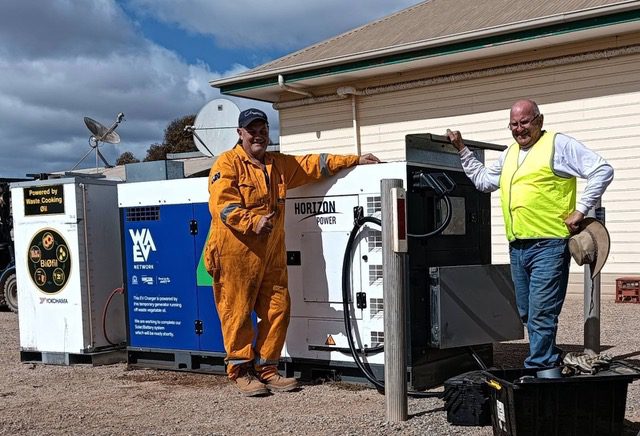The Biofil EV chargers designed by Jon Edwards in Perth to run on waste cooking oil have featured in several articles in The Driven, and have now gone “mainstream” as part of the charging network being rolled out in remote WA by Horizon Power for the West Australian government.
The first one has been deployed at Whim Creek in WA’s north as a temporary charger while the permanent off-grid system is being constructed, and a second has been transported to Caiguna on the Nullarbor route and commissioned by Jon last week, replacing the faulty original unit at this site.
The Whim Creek charger and the refurbished faulty unit will be relocated to Balladonia and Cocklebiddy roadhouses (also on Nullarbor route) later this year.
Horizon Power are also building an off- grid system at Mundrabilla roadhouse at the eastern end of the WA Nullarbor route to complete a fast DC charging network to the WA/SA border.
The location choices are in part due to whether the roadhouses saw value in working with Horizon Power to develop an off grid solution to power the entire site as well as a charger.
It is possibly complicated by the Federally funded NRMA national charger rollout also looking for sites, although this program has gone silent on the Nullarbor route after a single installation at Nullarbor roadhouse in SA.
The biofil chargers have featured in several articles in The Driven, and Jon has developed the them so that no input is required from roadhouse staff and a single button push starts the machine. On screen prompts are simple and the charger stops with another single button press.
The generator drives a robust DC charger which is not sensitive to frequency fluctuations and will deliver a fixed 60kW to any EV running up to 1000V architecture without overloading the generator. One unit with a smaller generator will be limited to 50kW. Each has a single CCS2 extra length cable.
The units are forklifted into place and are reasonably vandal proof, with the generator and charger enclosed in a steel cabinet with security screws to the doors and a lockable steel cover over the screen and controls.
The 24V battery to start the generator is kept topped up by trickle feed from a 40W solar panel. It runs for the first three minutes on diesel, automatically swaps to waste oil and switches off if no load is detected within that three minutes, in order to frustrate tamperers.
The Biofil has a 500 litre waste oil tank, or enough for over 30 charges. The chargers will be refilled via an arrangement through Horizon Power rather than relying on roadhouse staff.
The Biofils can be redeployed or used as backup units once Horizon Power installs permanent chargers.
The original Caiguna Biofil was in place for just under 3 years, following a crowdfunded “Plug the Gap” campaign in 2021. It ran for 600 hours, generated 27,000kWh and charged around 180 cars per year.
The number of EVs crossing the Nullarbor has risen from five in all of 2021 to more than 4 every week now. The roadhouses no longer create enough waste oil, and running the unit empty several times contributed to compounding problems.
We are fortunate in WA to have a tinkerer like Jon, and flexible and collaborative managers in Horizon Power who are open to innovative solutions.
A brief Biofil history:
October 2018: after a frustrating attempt to charge from Eucla BV roadhouse generator, Jon came up with the idea of a chargepod – a portable standalone generator and 50kW Tritium charger on a skid.
First chargepod built 2019, installed at Jurien Bay WA, running on diesel so attracted lots of adverse social media comments. Tritium RT 50 charger software adapted by company to pair with generator.
Wheels magazine hired this portable charger in 2019 for a trial of Tesla Model 3 in rural Victoria. Jon sourced biodiesel in Melbourne for this event.
Charger relocated to Arthur River to cover Perth – Albany route 2019. The roadhouse owner took Jon around the back and pointed out 4000 litres of waste cooking oil sitting in the shed and said “could yer use that?”
Since then, there have been multiple improvements to what was initially a basic waste oil charger, culminating in the version which was relocated to Caiguna in 2021 when a grid connected fast DC charger was located at Kojonup on the Albany route, allowing the Biofil to be moved to a more useful location.


